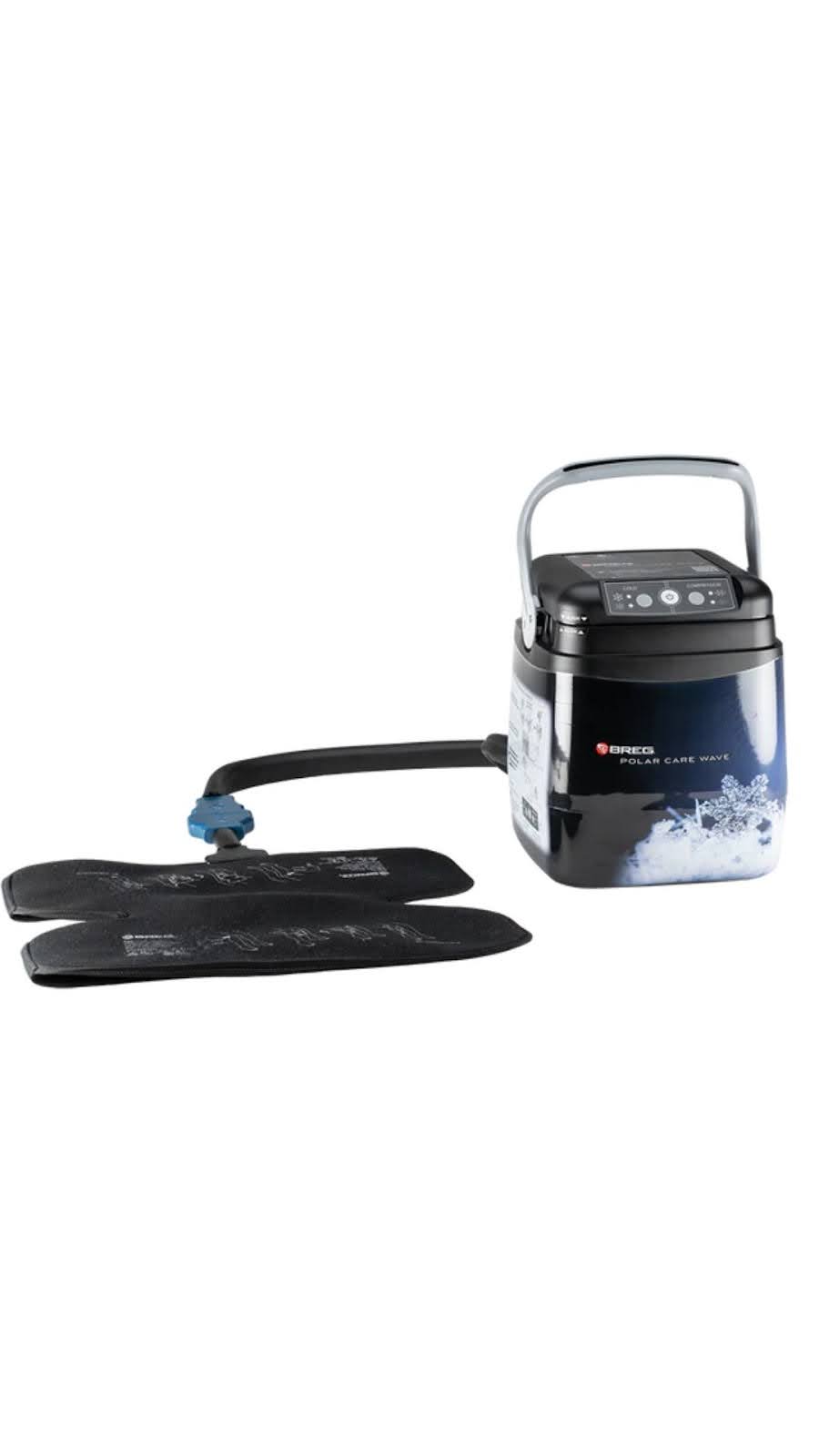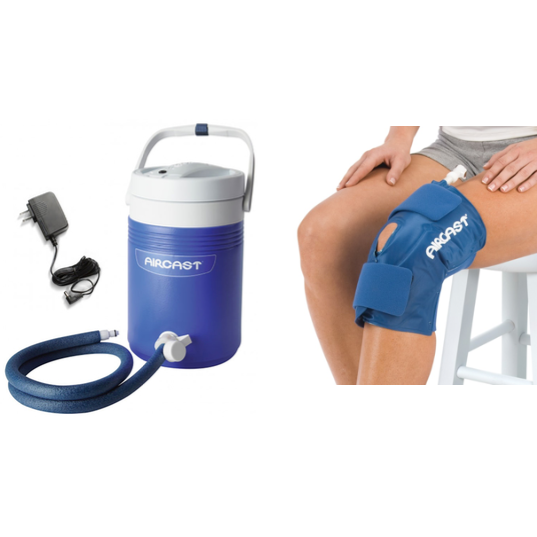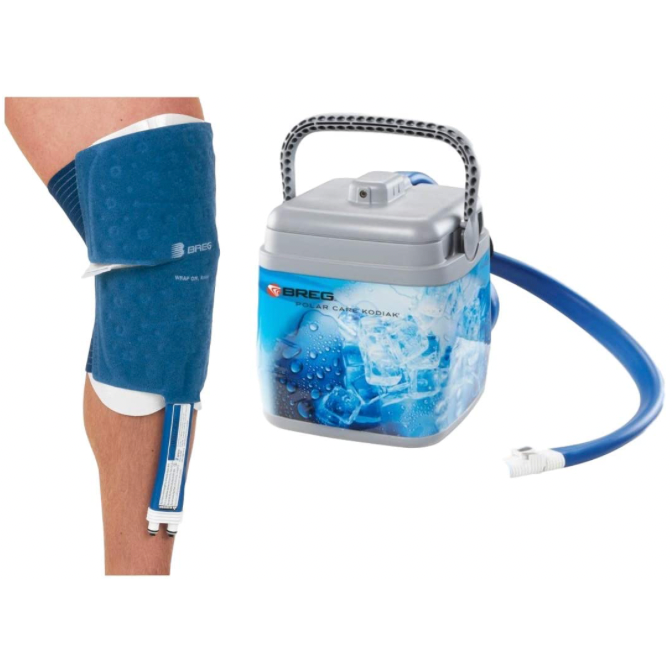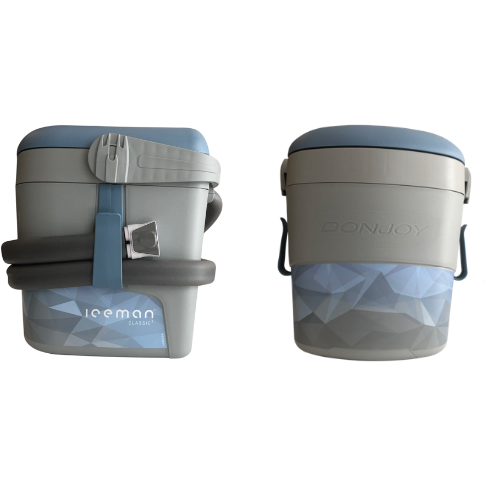Add your deal, information or promotional text
Recovering from knee surgery can be a challenging journey, filled with moments of discomfort and a quest for effective pain relief. Amidst the various recovery tools and strategies, finding the best ice machine for knee surgery stands out as a pivotal aspect of post-operative care. Ice therapy is crucial in reducing swelling, minimizing pain, and accelerating the healing process. It's essential, therefore, to choose an ice machine that delivers consistent, therapeutic cold and aligns with the highest standards of quality and effectiveness.
An ice machine for knee surgery recovery, often called a cold therapy unit, is a specialized medical device designed to provide targeted, sustained cold therapy to the knee area after surgery.
This treatment is instrumental in managing pain, reducing swelling, and speeding up the healing process following orthopedic procedures. Delivering consistent, controlled cooling to the affected area mitigates the need for traditional ice packs, which can be cumbersome and inconsistent in temperature maintenance.
These machines circulate chilled water through a pad or wrap that fits snugly around the knee, ensuring that the entire area receives the cooling effect. Unlike ice packs that fluctuate in temperature and require frequent changes, an ice machine for knee surgery provides a steady flow of cold therapy for a more extended period. This consistent cooling not only eases discomfort but also minimizes the risk of tissue damage from excessive cold.
Recovering from knee surgery can be a challenging journey, fraught with pain and a slow return to mobility. However, incorporating an ice machine into your rehabilitation routine can significantly ease this process. Using an ice machine post-knee surgery, a key component in your recovery arsenal can offer several noteworthy benefits:
Unlike traditional ice packs that warm up too quickly, an ice machine for knee surgery delivers consistent, prolonged cold therapy. This continuous flow helps maintain a steady temperature over your knee, effectively reducing swelling and inflammation. Continuous cold therapy aids in a more comfortable recovery, allowing for extended periods of use as needed for pain relief and inflammation reduction without the constant need for refreezing.
Knee surgeries, whether for torn ligaments or joint replacements, often leave the surrounding tissues swollen and painful. Ice machines designed for knee surgery come with wraps that conform to your knee, ensuring that the therapeutic cold reaches where it's needed most. This targeted approach to pain relief not only helps reduce medication dependency but also accelerates the healing process by minimizing tissue damage from inflammation.
Modern ice machine design caters to the user's convenience and safety. With clear instructions and easy-to-use setups, patients can independently manage their pain relief and swelling reduction without assistance. This independence in pain management is crucial for patients striving to reclaim mobility and normalcy in their lives.
Furthermore, the controlled temperature settings ensure that the cold therapy is delivered safely, reducing the risk of ice burns or frostbite, which can occur with improper use of traditional ice packs.
Integrating an ice machine into your post-knee surgery recovery alleviates pain and significantly speeds up healing. By diligently using cold therapy, patients can see a faster reduction in swelling, which, in turn, facilitates a better range of motion and strength exercises during physical therapy sessions. This enhanced recovery process leads to a quicker return to daily activities and, eventually, a higher quality of life post-recovery.
Understanding the different types of ice machines available can help you choose the best option for your knee surgery recovery.
Cold therapy units, often called cryotherapy machines, are designed to provide continuous cold therapy to the knee joint. These machines consist of a cooler filled with ice and water, a pump to circulate the cold water, and a pad that wraps around the knee. The cold therapy units are ideal for managing swelling and pain post-surgery, as they can deliver a consistent cold temperature over a prolonged period.
Motorized ice machines for knee surgery recovery take cold therapy a step further by integrating a motor to automate cold water circulation from the cooler to the wraparound pad. This feature eliminates manual intervention, making maintaining a consistently cold temperature over the knee easier.
Motorized ice machines benefit patients with limited mobility or who prefer a more convenient and efficient cold therapy solution. Breg is a reputable brand that offers motorized options with precise temperature control and ease of use.
Gravity-fed ice machines operate on a simple yet effective principle: cold water flows from a higher reservoir through a connecting hose to a pad around the knee. The natural force of gravity facilitates the movement of water, providing a gentle and continuous cold therapy experience. Although more basic than motorized, gravity-fed ice machines are lightweight, portable, and easy to use.
Portable ice wraps are an excellent choice for those seeking a more mobile option. These wraps can be filled with ice or gel packs and secured around the knee. While they do not offer the same level of continuous cold therapy as machines, portable ice wraps are incredibly convenient for short-term use, especially when moving.
Here are essential features to consider in making your selection:
The ideal ice machine should deliver consistent cold therapy over your entire knee area. This uniform distribution of cold helps in effectively managing pain and swelling. Look for machines designed to cover the knee comprehensively, ensuring no area is left untreated.
While some machines do not incorporate built-in timers, the capacity to sustain long-duration therapy sessions is vital. Machines that maintain cold temperatures for extended periods allow uninterrupted recovery intervals, adhering to medical recommendations for optimal healing times. Ensure the machine you choose can reliably support the duration of cold therapy prescribed by your healthcare provider.
Recovery can take a long time, making comfort a key factor in selecting an ice machine for knee surgery. Machines with adjustable straps or bands offer a customizable fit, ensuring the device remains in place without applying excessive pressure on the surgery site. Comfortable fit enhances the effectiveness of the treatment and the overall recovery experience.
Recovery from surgery can limit mobility and energy. Consequently, an ice machine that is easy to fill, operate, and maintain is essential. Look for units that require minimal effort to set up and can be operated without assistance, allowing for a stress-free recovery process.
Investing in a high-quality ice machine from reputable brands like AirCast, Breg, Chattanooga, DonJoy, and Exos ensures you receive a practical and durable product. High-quality materials and construction mean your ice machine can withstand regular use throughout your recovery.
A portable ice machine is advantageous, considering the need for regular cold therapy sessions. Whether you’re moving from room to room at home or need to bring your machine to physical therapy sessions, portability enhances the convenience of your recovery process.
Knowing how to use an ice machine safely post-surgery is paramount to avoid any setbacks in your recovery journey.
Before you start using an ice machine, it is crucial to understand its components and how it works. Typically, an ice machine consists of a cooler filled with ice and water, a pump that circulates the cold water through a connected hose, and a pad that wraps around the knee, allowing the cold to penetrate the surgical area. Familiarize yourself with the specific model provided.
While using an ice machine for knee surgery, it is vital to pay attention to the duration and frequency of each cold therapy session. Applying cold therapy for 20-30 minutes every 2 hours or as your healthcare provider advises is generally recommended. This intermittent approach helps maintain optimal pain relief and swelling reduction levels without overexposing the skin and tissue to cold temperatures.
Safety should always be your top priority. Always monitor your skin’s reaction to the cold. Before each session, examine your skin for irritation, numbness, or unusual color changes. Place a thin barrier, such as a cloth or a towel, between your skin and the cooling pad to prevent frostbite or other cold-related skin injuries. If you notice any adverse reactions, immediately cease cold therapy and consult your healthcare professional.
Maintaining the cleanliness of your ice machine and its components is also critical. Regularly check the manufacturer's instructions for proper maintenance and cleaning routines. This ensures the machine's longevity and keeps the risk of infection at bay, a particularly important consideration when recovering from surgery.
While the ice machine plays a crucial role in your recovery, balancing its use with prescribed rehabilitation exercises and sufficient rest is equally important. Cold therapy is most effective when combined with a comprehensive orthopedic surgery recovery plan tailored to your needs by healthcare professionals.
Below, we provide a comprehensive comparison guide to help you select the best ice machine for your knee surgery recovery from trusted brands like AirCast, Breg, Chattanooga, DonJoy, and Exos.
The AirCast Cryo Cuff Knee Cooler is designed to provide targeted cryotherapy to the knee, which can help minimize pain and swelling following surgery. This machine is simple to use, with an intuitive design that ensures users can manage their recovery process comfortably at home. The AirCast system balances cold therapy and compression, mimicking the body's natural healing processes.
Breg Polar Care Kodiak stands out for its versatility and effectiveness. It offers an easy-to-use, portable cryotherapy solution, making it a top choice for patients recovering from knee surgery. The Breg system is designed to deliver up to 8 hours of consistent cold therapy, ensuring extended pain relief and swelling reduction without the need for frequent ice pack changes.
The DonJoy Iceman Classic3 System is renowned for its dual pump recirculation system, which maintains extra cold and consistent temperatures. This feature is crucial for effective knee rehabilitation, as it helps to reduce pain and swelling more reliably than other systems with fluctuating temperatures. The Iceman Classic 3 is a top choice for those who require precise and consistent cold therapy for optimal knee recovery.
Selecting the right ice machine for knee surgery recovery is crucial for enhancing your healing process. Consider factors such as the duration of cold therapy delivery, ease of use, and the specific needs of your recovery process. Our carefully curated selection includes products that meet a wide range of recovery needs and preferences, all from reputable brands dedicated to quality and effectiveness in orthopedic care.
Here, we offer practical tips to maintain your ice machine for durability and long-lasting performance.
Regular cleaning is crucial to prevent the build-up of mold and bacteria, which can happen if water is left in the machine for an extended period. After each use, empty any remaining water and ice from the reservoir and therapy pads.
Wipe down all surfaces with a mild detergent and warm water, then dry thoroughly before storing. For models with removable parts, disassemble these components and clean them individually to ensure no area is overlooked.
Regular inspections can help identify potential issues before they escalate into serious problems. Check the hoses and connections for any signs of wear or damage, such as cracks or leaks.
If your machine uses filters, ensure they are clean and replace them according to the manufacturer's guidance. For safety reasons, inspecting electrical cords for fraying or damage is also essential.
Store your ice machine in a cool, dry place when not in use. Avoid exposure to direct sunlight or extreme temperatures, as they can damage the machine's components over time. If your device has any detachable parts, disconnect them and store them separately to prevent any connection strain or damage.
Follow the manufacturer's instructions for the appropriate amount of ice and water to use, ensuring the machine operates efficiently and avoids any damage to the system. It's also crucial to adhere to the recommended usage times for each therapy session to avoid skin damage or other health risks, focusing on how long the ice machine should be used rather than strictly on device-specific features like timers.
Finally, if your ice machine for knee surgery isn’t performing as expected, consider professional servicing. Attempting to fix problems yourself can sometimes lead to further damage or void the warranty. Consult the user manual for troubleshooting tips or contact the manufacturer for advice or professional repair services.
Regarding knee surgery recovery, one of the critical aspects of care is effectively managing pain and swelling post-operation. This is where the role of an ice machine for knee surgery becomes invaluable not only in the immediate aftermath of surgery but also for long-term knee health and mobility. Understanding when to invest in an ice machine can be pivotal in ensuring a smoother recovery process and preserving the long-term function of your knee.
Immediately after orthopedic surgery, your medical team will focus on reducing swelling and pain in your knee. This period is crucial as excessive swelling can lead to complications and prolong recovery.
An ice machine designed for knee surgery recovery can deliver consistent, controlled cooling, deeply penetrating the affected area to reduce inflammation and numb the pain. This consistent and controlled application of cold therapy helps to accelerate the early stages of healing.
For individuals with chronic knee conditions such as osteoarthritis or recurrent knee injuries, an ice machine isn't just a post-operative recovery tool; it's a component of ongoing self-care and pain management.
Regular use of an ice machine can help manage daily discomfort and inflammation, improving your overall quality of life and potentially delaying the need for further surgical interventions.
Athletes or individuals engaged in high-impact sports and activities might consider an ice machine as a preventive measure for post-exercise recovery. After particularly strenuous activity, the knee joint can swell and become painful, a situation where the immediate application of cold therapy can reduce the risk of injury or long-term damage.
Incorporating an ice machine into a regular health and wellness routine can be a game-changer for those who lead active lives or have jobs that place significant strain on their knees. It not only aids in post-exercise recovery but also helps manage everyday wear and tear on the knee joint.
Investing in an ice machine for knee surgery is a step towards ensuring a comprehensive recovery and preserving your knee's long-term health. By understanding when to incorporate this technology into your care regimen, you can make an informed decision that will support your recovery journey and beyond.
Read also:
How Tight Should a Knee Brace Be?
Ice machines for knee surgery provide continuous, targeted cold therapy to the affected area, which can more effectively reduce pain, swelling, and inflammation than traditional ice packs. Unlike ice packs that warm up over time and require frequent changes, ice machines maintain a consistent temperature, providing prolonged relief without needing constant attention. This allows for a more convenient and effective recovery process.
Using an ice machine while sleeping is generally not recommended unless it has specific safety features that allow for safe overnight use. To avoid risks such as frostbite or skin damage, ensure the ice machine has temperature control settings and automatic shut-off capabilities. It is also wise to follow the manufacturer's guidelines on the use duration and consult with a healthcare professional.
The duration of icing your knee post-surgery varies depending on individual recovery rates and the specific instructions of your healthcare provider. In general, it's common to apply cold therapy for the first 48 to 72 hours continuously, as needed, to help manage pain and swelling. After this initial period, your doctor may advise you to continue using ice therapy several times a day for up to two weeks or as long as it aids your recovery.
Common post-operative mistakes include neglecting recommended rehabilitation exercises, putting too much weight on the affected leg too soon, and skipping follow-up appointments with the healthcare provider. Overusing or underusing cold therapy, such as not using an ice machine for knee surgery recovery as advised, can hinder the healing process. Adhering to all post-surgery instructions is crucial to ensuring a smooth and efficient recovery.
Yes, icing the knee after surgery can help speed up healing. Cold therapy reduces blood flow to the affected area, which can decrease inflammation, swelling, and pain. This, in turn, can facilitate a quicker recovery by allowing you to start rehabilitation exercises sooner and more comfortably. However, it should be noted that icing is most effective when combined with other recommended post-surgery practices.
It's not uncommon for the knee to remain swollen for a few weeks after surgery. The duration of swelling can depend on several factors, including the extent of the surgery, your body's natural healing process, and how well post-operative care instructions (such as icing, elevation, and rehabilitation exercises) are being followed. Persistent or worsening swelling beyond the expected recovery timeline, however, should be evaluated by a healthcare professional to rule out complications such as infection or issues with the surgical repair.



